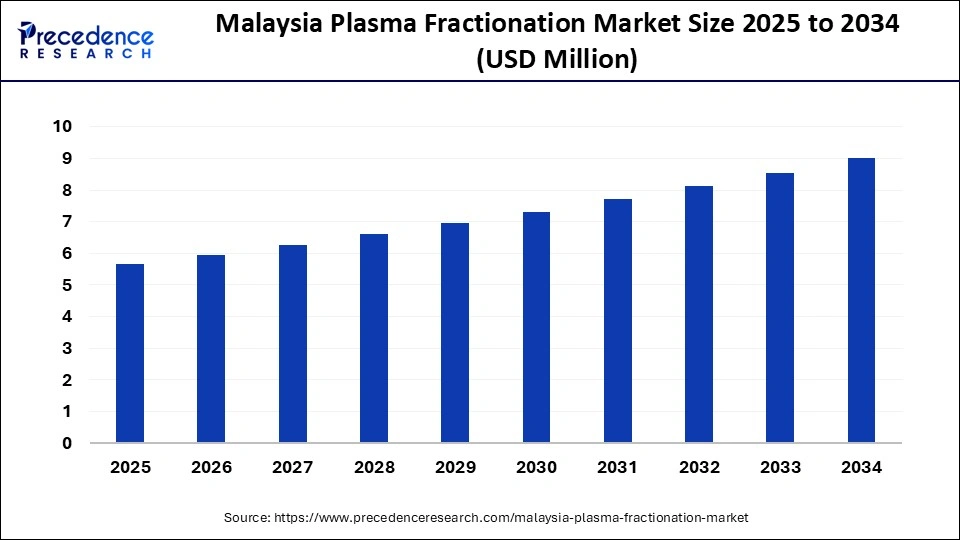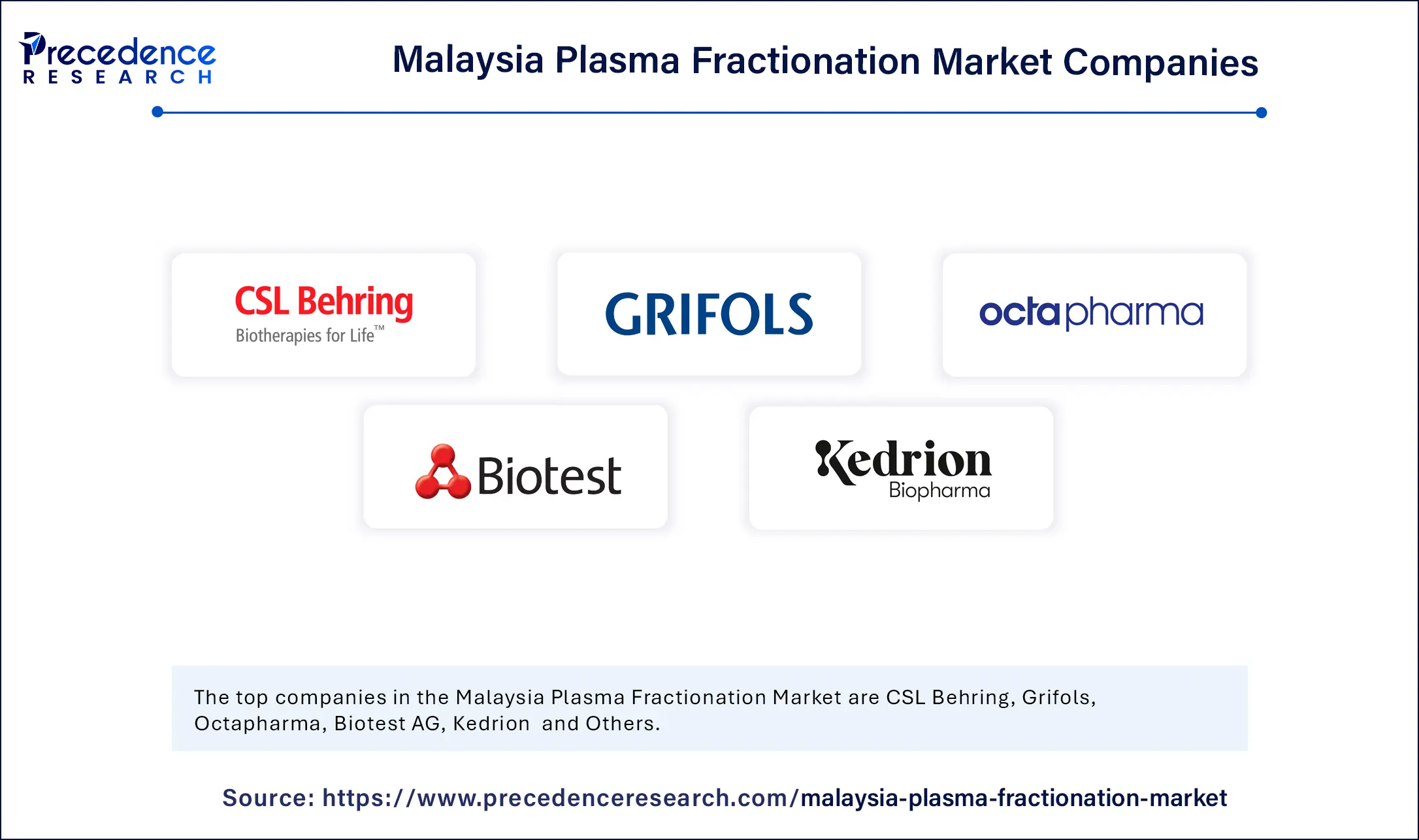List of Contents
Malaysia Plasma Fractionation Market Size and Forecast 2025 to 2034
Discover how the Malaysia plasma fractionation market is expanding with rising demand for immunoglobulins, albumin, and clotting factor therapies. The growth of the Malaysian plasma fractionation market is driven by the rising demand for plasma-derived therapies and strong government support.

Malaysia Plasma Fractionation MarketKey Takeaways
- By method, the centrifugation segment contributed the largest market share in 2024.
- By method, the chromatography segment will grow at the fastest CAGR during the forecast period.
- By product, the immunoglobulin segment dominated the market in 2024.
- By product, the coagulation factors segment is projected to witness the fastest growth during the forecast period.
- By application, the neurology segment captured the biggest market share in 2024.
- By application, the oncology segment will grow at a considerable CAGR in the market during the forecast period.
- By end use, the hospitals and clinics segment held a major revenue share in 2024.
- By end use, the clinical research segment is projected to grow rapidly in the market during the forecast period.
How is AI Transforming the Plasma Fractionation Market in Malaysia?
Artificial intelligence is positively impacting the Malaysia plasma fractionation market by streamlining operations, enhancing product quality, and ensuring regulatory compliance. The application of AI helps to improve the way plasma processing is done, leading to higher-quality products like immunoglobulins and coagulation factors. AI-driven real-time data monitoring ensures safe and compliant operations. This integration boosts efficiency, scalability, and reliability in plasma fractionation, all of which are beneficial for both patients and the healthcare system.
Market Overview
The plasma fractionation involves the separating plasma from blood to produce essential proteins such as albumin, immunoglobulins, and coagulation factors, which are crucial in managing conditions like hemophilia and various blood disorders. In Malaysia, the demand for plasma-derived therapies is on the rise due to increased awareness, advancements in medical services, and a higher incidence of chronic and rare diseases.
The government and private sectors in Malaysia are collaborating to encourage sustainable plasma processing, increasing the country's involvement in the international plasma therapeutics field. This is supported by the development of more plasma collection centers across the country to ensure a steady supply of raw plasma. Malaysia's focused efforts in healthcare, collaborative work with foreign plasma producers, and increasing investments at the local biopharmaceutical level are projected to drive significant market growth.
There is fast progress in the Malaysia plasma fractionation market as pharmaceutical companies are increasingly adopting new technologies, including digitalized, automated, and smart workflows. These developments increase how efficiently the company works, provide patients with better products, and meet the greater need for plasma-based products while guaranteeing safety and effectiveness. Malaysia is steadily becoming a hub for plasma fractionation, providing pharmaceutical companies with immense opportunities.
What Factors are Fueling the Growth of the Malaysian Plasma Fractionation Market?
- Rising Prevalence of Chronic Diseases: The rising number of patients of chronic and rare disorders, such as hemophilia and autoimmune disorders is driving the demand for plasma therapy.
- Government Support and Policy Initiatives: Involvement of the government leads to more investments in R&D and partnerships with foreign companies, which greatly boost the market's development.
- Expansion of Plasma Collection Infrastructure: The establishment of new plasma collection centers in Malaysia means a better and easier availability of plasma for processing in the region.
- Public Awareness and Donation Campaigns: Increased public awareness about plasma donation encourages more voluntary donations. Increases in donations lead to more plasma being available, which allows stable production and plays a big part in the market's development and in meeting the needs of patients.
- Strategic Partnerships and Industry Investment: Collaborations between Malaysian medical centers and international biopharmaceutical firms are accelerating research, development, and mass production.
Market scope
| Report Coverage | Details |
| Base Year | 2024 |
| Forecast Period | 2025 to 2034 |
| Segments Covered | Product, Method, Application, End Use |
Market Dynamics
Drivers
Rising Incidences of Immunodeficiency Disorders
The rise in the number of cases of immunodeficiency diseases is driving the growth of the Malaysia plasma fractionation market. Plasma-derived medicines, such as immunoglobulins and coagulation factors, are used to treat immunodeficiencies, autoimmune conditions, and inflammatory disorders. Also, the medical field keeps discovering more ways to apply plasma-derived immunoglobulins.
The World Health Organization (WHO) has granted PDMPs such as albumin, immunoglobulins, and clotting factors, highlighting their effectiveness. As more patients require healthcare and diagnostic skills improve, plasma therapies are becoming more widely used in Malaysia. Consequently, the rising demand for the treatment of immunodeficiency is expected to boost the expansion of Malaysia's plasma fractionation market.
Restraint
Availability of Alternatives
The Malaysian plasma fractionation market's growth is being hindered by the rise of recombinant therapies. These therapies are preferred by medical professionals due to their availability as alternatives to many plasma-based drugs. The increasing trust and use of recombinant therapies have limited the growth of plasma-derived treatments in these areas. Therefore, the expanding use and advantages of recombinant therapies are negatively impacting the growth of the market.
Opportunity
Launch of New Technologies
The major opportunity in the Malaysia plasma fractionation market lies in the introduction of new and innovative technologies. These advances are vital to increase the production of safe plasma-derived products and widen therapeutic applications. They reduce the chances of contamination and help maintain the same quality of the therapeutic proteins, which is crucial for patients.
Because of the introduction of new technologies, scientists have the opportunity to develop better plasma-derived treatments, including longer-lasting coagulation factors and advanced immunoglobulins. These drugs are gaining acceptance in more treatment areas by improving patient convenience through reduced doses and enhanced medical outcomes.
Method Insights
Why Did the Centrifugation Segment Dominate the Market in 2024?
The centrifugation segment dominated the Malaysia plasma fractionation market with a major revenue share in 2024 because it plays a crucial role in efficiently separating the blood to obtain high-quality plasma. By spinning blood at a high speed, plasma is isolated from cells, as different densities cause blood components to separate during centrifugation. Centrifugation has the potential to separate red blood cells, white blood cells, and platelets, enhancing its versatility for clinical and research applications. Technological innovations ensure efficient plasma processing at a lower overall cost, supporting centrifugation as a plasma fractionation method.
The chromatography segment is expected to grow at the fastest rate during the forecast period. In particular, Ion exchange, affinity, and size exclusion chromatography are used to carefully separate and purify proteins like coagulation factors, protease inhibitors, and anticoagulants in blood. This is crucial for producing advanced plasma-derived therapies that are safe and effective. Recent technological advancements, including modern chromatographic materials, automation, and real-time monitoring, have improved purity and reduced production costs.
Product Insights
What Factors Contributed to the Immunoglobulin Segment's Dominance in the Market in 2024?
The immunoglobulin segment dominated the Malaysia plasma fractionation market in 2024. Immunoglobulin therapies are vital in managing autoimmune diseases, immune deficiencies, and inflammatory conditions because they can modulate the immune response. The safety and effectiveness of immunoglobulin products continue to improve with each advancement, expanding their applications. Rising awareness of its benefits among healthcare professionals and patients drives the demand for immunoglobulin therapy. Additionally, the increasing incidence of immune-related disorders and improved diagnostic methods contribute to the growing popularity of immunoglobulins.
The coagulation factors segment is expected to grow at the highest CAGR in the coming years. Coagulation factors are essential for managing bleeding disorders and surgical procedures. Many doctors rely on plasma-derived coagulation factors to control blood loss in endoscopy and gastrointestinal surgeries. The increasing cases of sickle cell anemia and hemophilia globally have increased the demand for coagulation therapies. Advancements in longer-lasting and more effective coagulation factors also boost market growth. The demand for coagulation factors is expected to grow rapidly due to the rise in patients opting for replacement therapies for excessive bleeding and improved quality of life.
Application Insights
Why Did the Neurology Segment Dominate the Market in 2024?
The neurology segment dominated the Malaysia plasma fractionation market with the largest share in 2024. IVIg and plasmapheresis therapy have been proven effective in treating various neurological diseases, such as MS, Guillain-Barré syndrome, and chronic inflammatory demyelinating polyneuropathy. The demand for plasma-derived products has increased due to the growing prevalence of nerve diseases, as they reduce inflammation and regulate the immune system. Advancements in neurology field have led to greater expansion in the plasma therapy market. Increased awareness of plasma therapy among healthcare professionals in neurology has boosted its adoption in clinical treatment. The neurology division is projected to remain the leading segment of the market due to the increasing patient numbers and continuous improvements in available therapies.
The oncology segment is expected to grow at a significant rate during the forecast period due to the increased use of plasma-based therapies in cancer patients. Intravenous immunoglobulin (IVIg) and similar products are now recognized for treating infections and complications associated with cancer and its treatments, such as immune deficiencies. The rising global incidence of cancer and government focus on cancer treatment have driven the demand for plasma-based therapies. New approaches, like plasma-assisted cancer immunotherapy and cold atmospheric plasma (CAP) therapy, are benefiting patients and encouraging their use in clinical settings.
End-use Insights
Why Did Hospitals & Clinics Segment Dominate the Malaysia Plasma Fractionation Market in 2024?
The hospitals & clinics segment dominated the market by holding the largest share in 2024. The growth of the segment is primarily driven by an increase in hospitals around the world and the modernization of healthcare facilities. Plasma products like IVIg and albumin are primarily administered in these facilities for treating autoimmune diseases, cancer, liver issues, and trauma cases. The availability of well-trained healthcare personnel in clinical settings increases the use of plasma treatments, leading to improved patient care. Increased hospital admissions due to chronic diseases and an aging population are making plasma fractionation products more necessary. Improvements in plasma gathering and storage in hospitals and clinics enhance the safety and accessibility of these therapies.
The clinical research segment is expected to grow rapidly over the studied period. Plasma therapy is increasingly used to manage rare and complex diseases. The development of new plasma-based treatments, including IVIg, albumin, and clotting factors, is a key driver of this segment's growth. Ongoing clinical trials are crucial for evaluating product safety and efficacy, which supports regulatory approvals. Increased focus on clinical research leads to the development of innovative products, improving patient access. Consequently, clinical research is vital for boosting the plasma fractionation sector, fostering market expansion, and introducing more plasma-derived treatments for patients.
Recent Development
- In June 2025, GC Biopharma signed a toll-manufacturing agreement with Solid Intellectual SDN BHD (SISB), a subsidiary of Malaysia's prominent JAKEL Group, for the supply of plasma-derived therapeutics. Under the contract, Malaysia's health authorities will provide domestically collected plasma to SISB, which will then deliver it to GC Biopharma.
(Source: https://kormedi.com)
Malaysia Plasma Fractionation Market Companies

- CSL Behring
- Grifols
- Octapharma
- Biotest AG
- Kedrion
Segments Covered in the Report
By Product
- Albumin
- Immunoglobulins
- Intravenous immunoglobulins
- Subcutaneous immunoglobulins
- Others
- Coagulation factors
- Factor viii
- Factor ix
- Von willebrand factor
- Prothrombin complex concentrates
- Fibrinogen concentrates
- Others
- Protease inhibitors
- Others
By Method
- Centrifugation
- Depth filtration
- Chromatography
- Others
By Application
- Neurology
- Hematology
- Oncology
- Immunology
- Pulmonology
- Others
By End Use
- Hospitals & clinics
- Clinical research
- Others
For inquiries regarding discounts, bulk purchases, or customization requests, please contact us at sales@precedenceresearch.com
Frequently Asked Questions
Ask For Sample
No cookie-cutter, only authentic analysis – take the 1st step to become a Precedence Research client